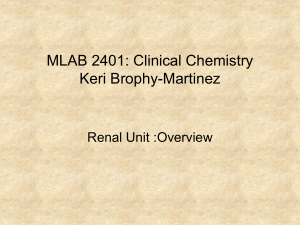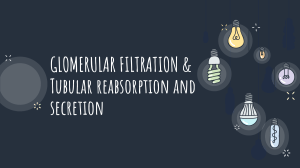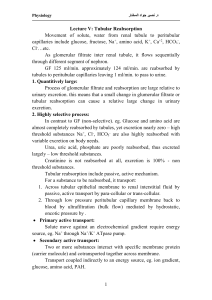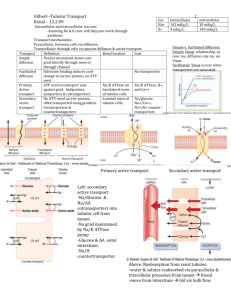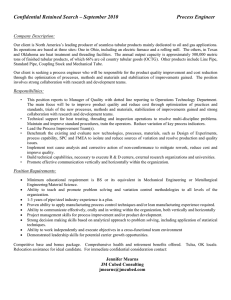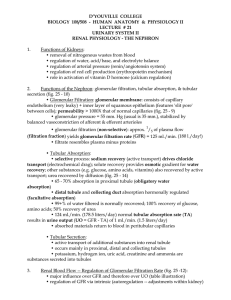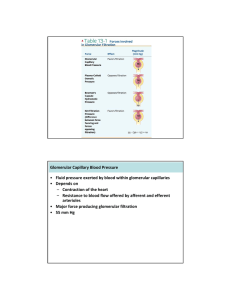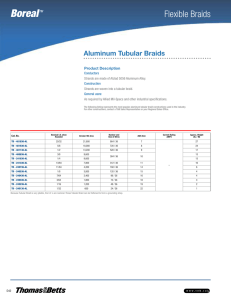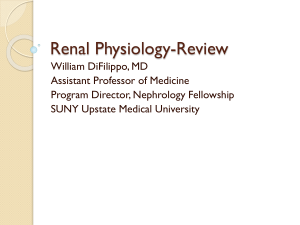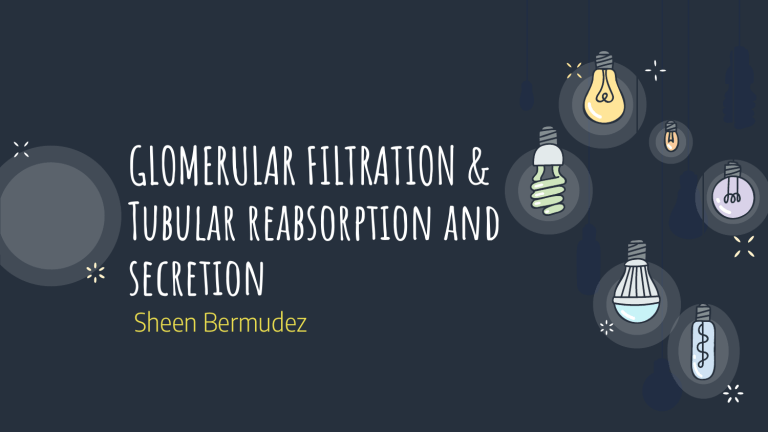
GLOMERULAR FILTRATION & Tubular reabsorption and secretion Sheen Bermudez Glomerular Filtration Excretion Tubular Reabsorption & Secretion 2 GLOMERULAR FILTRATION Formation of urine Blood passes through the capillary endothelium, the basement membrane, and the epithelium of Bowman’s capsule into Bowman’s space 3 ⊹ Starling forces - responsible for glomerular filtration - GFRs higher than the systemic capillaries (due to glomerular capillary barrier) ⊹ Hydrostatic pressure (HP) fluid out of capillary ⊹ Colloidal osmotic pressure (COP) opposes HP; draws fluid in 4 Ultrafiltrate of Plasma ⊹ filtered fluid, similar to interstitial fluid ⊹ contains water and all of the small solutes of blood ⊹ but it does not contain blood cells and proteins ( mol weight of 70,000 and above) Plasma haptoglobin (a plasma protein) ⊹ Binds to hemoglobin to prevent leakage at the glomerulus. 5 Hemoglobinuria ⊹ Hemoglobin begins to appear in the urine ⊹ Excessive intravascular lysis of RBC = haptoglobin becomes saturated Acute renal shutdown ⊹ Blocked tubules due to high tubular hemoglobin concentration 6 Factors that influence GFR Changes in the diameter of the arterioles. Dilation of afferent arteriole = ↑ BF to the glomerulus = ↑ HP = ↑ filtration. Constriction of the efferent arteriole = ↑ glomerular HP; ↓ renal blood flow (RBF). Neural and humoral factors capable of affecting these diameter changes. Negative charge of Proteoglycans (basement membrane) positively charged molecules are more readily filtered than negatively charged molecules. Poor perfusion of the kidneys cans result in a change in the electrostatic charge of the membrane, and molecules previously restricted from filtration can be filtered and gain entrance to the capsular space. ⊹ ⊹ ⊹ ⊹ ⊹ 7 Autoregulation ⊹ RBF and glomerular filtration rate (GFR) remain relatively constant within a wide range of mean systemic arterial pressure. (80 - 130 mmHg) ⊹ intrinsic to the kidney and independent of renal nerve activity Myogenic stretch receptor response in afferent arteriole ⊹ ↑BP = arteriole contracts = ↓ RBF and glomerular HP = ↓ GFR. ⊹ ↓ BP = arteriole dilate = ↑RBF and glomerular HP = ↑ GFR 8 Tubuloglomerular feedback. ⊹ Afferent arteriolar feedback mechanism & Efferent arteriolar feedback mechanism ⊹ ↓ GFR = ↓ FR in loop of Henle = ↑ reabsorption of Na and Cl ions in the ascending limb = ↓ NaCl at the macula densa cells. ⊹ Macula densa sends signal to afferent arterioles to ↓ resistance to blood flow = ↑ glomerular HP, helping to return GFR to normal. ⊹ Macula densa cells sense changes in volume delivery to the distal tubules ⊹ It also increases release of renin from the juxtaglomerular (JG) cells of the afferent and efferent arterioles (major storage sites for renin). 10 ⊹ ⊹ ⊹ Angiotensinogen converted to angiotensin I by renin Renin, an enzyme, increases the formation of angiotensin I Angiotensin‐converting enzyme (ACE) converts angiotensin I to angiotensin II; from capillary endothelium of the lung, kidney endothelium and other organ beds ⊹ Angiotensin II constricts the efferent arterioles = ↑ GHP & GFiltration; second most potent vasoconstrictor produced in the body; stimulates the secretion of aldosterone, which causes reabsorption of Na+. ⊹ ⊹ Vasopressin most potent vasoconstrictor Angiotensinases rapidly destroys angiotensin II in the peripheral capillary beds 11 Angiotensinogen Renin Angiotensin I Angiotensin-converting enzyme Angiotensin II destroy Angiotenases constricts Efferent arterioles ↑ GHP & GFR 12 Tubular transport ⊹ ⊹ refers to all phenomena associated with tubular fluid throughout the nephron and collecting ducts. Transport from Bowman’s capsule to the renal pelvis is accomplished by a difference in HP (high in Bowman’s capsule, low in renal pelvis). Tubular reabsorption ⊹ Tubular reabsorption involves transport of water and solute from tubular fluid to peritubular capillaries. Tubular secretion ⊹ Tubular secretion is associated with transport of solute from peritubular capillaries to the tubular fluid. 13 Peritubular capillaries ⊹ reabsorb fluid from tubules ⊹ Higher COP than the tubular fluid COP (proteins not filtered) ⊹ Reduction in HP lessens its counteractive force to the COP. 14 Tubular reabsorption ⊹ Substances important to body function (Na+, glucose, & AA) have relatively small molecular size ⊹ Concentrations in the filtrate are about equal to plasma. ⊹ Excreted in the urine if not absorb ⊹ Energy is supplied by the Na+/K+‐ATPase pump (sodium pump) on the basal and lateral surfaces of the tubular epithelial cells. 15 ⊹ Cotransport (symport) simultaneous transport of two or more compounds on the same carrier & same direction (e.g., Na+ plus glucose, or Na+ plus amino acid) ⊹ Countertransport (antiport) movement of a compound in opposite direction of the second compound (e.g., Na+–H+ countertransport). 16 17 Sodium absorption ⊹ About 65% occurs in the proximal tubule by three ⊹ ⊹ ⊹ ⊹ ⊹ major mechanisms. 25% in the ascending limb 10 % in distal tubule Proximal tubule to the peritubular capillaries. Reabsorption is accompanied by anions to maintain electrical neutrality (75% Cl– & 25% HCO3–) tightly coupled to passive water reabsorption, meaning when sodium moves, water follows 18 First mechanism ⊹ Na+ readily diffuses because of: ⊹ When Na+ is actively transported, electrochemical gradient between the tubular epithelial cells and the tubular lumen ⊹ The membrane contains carrier proteins specific for Na+ coupled with either glucose or an amino acid (cotransport). ⊹ Peritubular space become electropositive due to Na+ transport ⊹ To maintain electrical neutrality, Cl– ions readily diffuse from the tubular lumen to the peritubular space 19 second mechanism ⊹ Countertransport with H+ ⊹ The epithelial cells of the proximal and distal tubules, and collecting ducts all secrete H+ ions (hydration of CO2 within the epithelial cells = H+ and HCO3 –) ⊹ The HCO3 – ions diffuses through the membranes into the peritubular space to maintain electrical neutrality with the Na+ that was countertransported with the H+. 20 third mechanism ⊹ ⊹ ⊹ ⊹ ⊹ chloride‐ driven Na+ transport occurs in more distal portions of the proximal tubules. There is more HCO3 – being reabsorbed into the peritubular space as anion rather than Cl– Cl– concentration increase in the tubule creates a gradient for its diffusion into the peritubular space through the “leaky” tight junctions. This is accompanied by diffusion of Na+ in the same direction to maintain electrical neutrality 21 Glucose and amino acid reabsorption ⊹ reabsorbed by cotransport ⊹ They are coupled with specific carriers that require Na+ binding and diffuse to the cell interior because of the electrochemical gradient for Na+. ⊹ Inside the cell, the Na+ and glucose or amino acids separate from the carrier. ⊹ specific carriers are present for facilitated diffusion of glucose and amino acids into the peritubular space. 22 Transport of water and nonactively reabsorbed solutes ⊹ ↑ solute in peritubular space = ↑ effective osmotic pressure in peritubular space = water diffuses to the peritubular space. ⊹ Urea and other nonactively reabsorbed solutes are concentrated in the lumen (chemical gradient) and they are reabsorbed down their concentration gradient. ⊹ Reabsorption is dependent on the permeability of the proximal tubular epithelium for the solute. 23 Reabsorption of proteins and peptides ⊹ ⊹ ⊹ ⊹ ⊹ Most proteins are reabsorbed in the proximal tubule and are not lost in the urine but a small quantity of protein is present in normal urine. Proteins (and polypeptides) are reabsorbed by endocytosis and degraded by lysosomes to AA. The amino acids reabsorb by facilitated diffusion. Small peptides are hydrolyzed and the amino acids are taken into the cell by the cotransport mechanism Small‐peptide hydrolysis is a high‐capacity mechanism capable of returning to the body large amounts of amino acids 24 Tubular secretion ⊹ ⊹ ⊹ ⊹ Transport of solute from peritubular capillaries to the tubular fluid. Example: counter transport of H+ with Na+ reabsorption Distal nephron H+ secretion an active process that occurs in the intercalated cells of the collecting duct; No Na+ absorption Renal K+ transport is reabsorbed in some parts of the tubule and secreted in others. ⊹ ↓ dietary potassium intake = ↑ K+ reabsorption in distal tubule ⊹ ↑ dietary potassium intake = ↑ K+ secretion. 25 ⊹ ⊹ Penicillin is lost from the body fluids because of tubular secretion. A longer‐acting penicillin that has been developed persists in the body for longer periods because its rate of secretion has been slowed. 26 Tubular transport maximum (Tm) ⊹ ⊹ maximum rate at which substances can be reabsorbed Tm is exceeded, the substance will appear in the urine. Diabetes mellitus ⊹ lack of insulin causing impaired movement of glucose from plasma into body cells ⊹ ↑ glucose concentration in plasma = ↑ tubular loads of glucose ⊹ Excess glucose continues its flow into the urine. ⊹ Glucose retained within the tubules = ↑ effective osmotic pressure of the tubular fluid ⊹ Diuresis increased urine formation ⊹ Osmotic diuresis retention of water due to ↑ effective osmotic pressure 27 Glomerulotubular balance ⊹ Property of the proximal tubule to reabsorb a consistent fractional amount of glomerular filtrate (about 65% for water & NaCl) ⊹ If the GFR is low, only a fractional amount of filtrate is reabsorbed and the remaining fraction (about one‐third) continues to the distal nephron where the regulatory processes are given a chance to operate. 28 The End… 29
